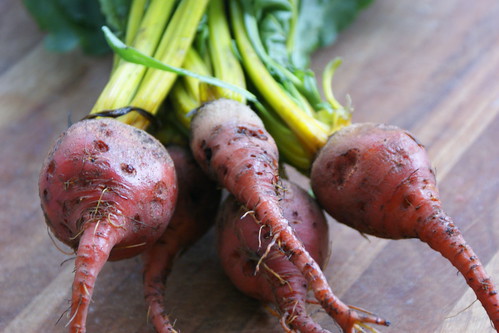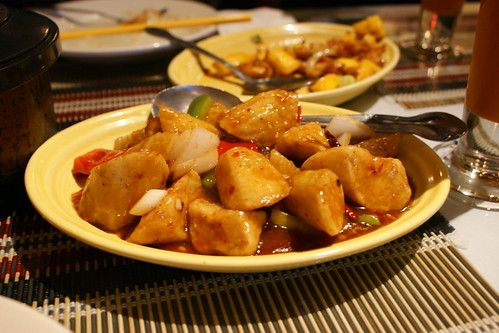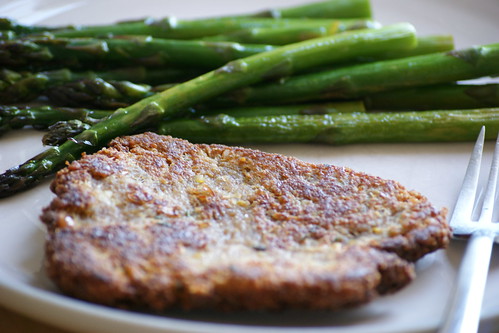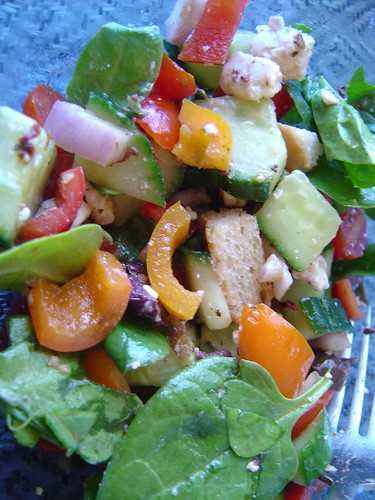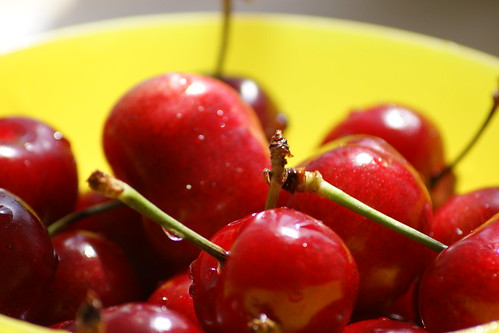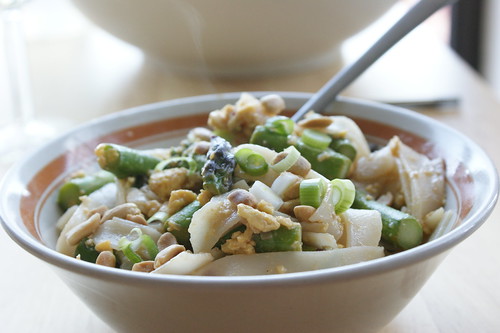I just realized that the beet salad I just blogged about may be confusing to some people because the beets are not red. They are golden beets. As you can see from the picture the are a little orangish before they are peeled and are a little more yellow on the inside. They do not stain as much as red beets obviously and their flavor is very different. The golden beets are more nutty and more reminiscent of the flavor of a carrot than red beets. They still have the earthy flavor of beets though and can be subbed for beets in any recipe.
Thursday, May 29, 2008
Beet Salad.....
Also known as the best beet salad ever! This turned out so well. It is a modified version of Beets with Lemon, Cilantro, and Mint from Vegetarian Cooking for Everyone by Deborah Madison.
The recipe calls for cooked beets, the zest and juice of a lemon, diced red onion, parsley, cilantro, mint, ground coriander, olive oil, salad greens, and oil cured olives. We followed the recipe except for a few modifications.
We cooked the beets in our usual way: peeled, cut into small pieces, put in tin foil with a little bit of olive oil, salt, pepper, and about a tablespoon of balsamic vinegar, and baked at 400 degrees for about 40 minutes. We also baked some carrots along with the beets. We made the dressing according to the recipe, but left out the parsley. Once the beets and carrots were cooked, we mixed them with the dressing. Instead of salad greens, we put the beets and carrots over purslain. Purslain looks kind of like thin succulent leaves and tastes kind of like a cross between arugula and cactus--but really it has a taste all of its own.
We were going to leave the olives out because of the added balsamic vinegar, but decided to add them at the end (after this picture was taken). We used kalamata olives instead of oil cured olives. The salad was already really good, but the olives made it out of this world. The baby beets from the farmer's market were so tender and tasty and the purslain worked so well with all of the other flavors. This salad was a real winner. It kind of reminded me of some of the salad dishes we have had a Millennium (which makes me wonder if lemon and mint is the secret to some of their salads).
Wednesday, May 28, 2008
Biscuits and Burnt Flour Gravy (with Melon)
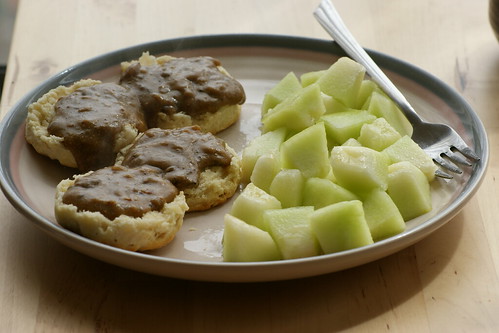
We were craving the biscuits and gravy from the sadly defunct Globe Cafe in Seattle, and since we are something like 500 plus miles and about a year too late to eat at the Globe, we decided to make our own, using Alexa frozen biscuits and a modification to my great grandmother's basic burnt flour gravy.
Burnt flour gravy is a really common thing in West Virginia, It's a good way to add some flavor to a meal and stretch a buck at the same time.
Burnt Flour Gravy:
1 Shallot, diced.
4 T Flour
1 T nutritional yeast (aka, Brewer's yeast.)
1 teaspoon cumin
1/2 teaspoon salt
generous dash of cayenne pepper
1 cup water
Mix together the flour, yeast, salt, cumin, and pepper until pretty well mixed up.
Heat 2 or 3 T Canola oil in a skillet until hot. (Traditionally this would be the hot rendered fat from fried chicken or roast beef, along with the browned bits of the meat, called "Drippings" in West Virginia, naturally this isn't vegetarian, so we use the shallots to take their place. the gravy doesn't miss the meat at all.) Add the shallots and cook until golden brown. Slowly sprinkle the flour mixture into the hot oil, like snow. Mix the flour into the oil with a wooden spoon until it becomes a bit of a dry paste. (this is called a roux.) Spread this out as much as possible and let the flour toast in the skillet. The longer this toasts, the darker the gravy will be. The gravy can range from a white gravy, (The Globe's was closer to a white gravy, made with mushrooms i addition to the shallots,) which is toasted just little bit, to a deep brown gravy, which is truly the burnt flour gravy. The burnt flour takes on a bitter, nutty flavor which is really the trademark of appalachian burnt flour gravy.
When the roux is a nice light brown, add the water in a slow stream and stir constantly. As soon as it hits the pan, it will steam up and mix with the burnt flour and form a thick starchy gravy, add more and more water till the gravy is at the desired thickness. Once it is there, take it off the heat or it will lose the water and thicken up more.
Serve the gravy on top of stuff.
EDIT: Here's a variation on the gravy that's very close to the Globe's Mushroom Gravy.
2 to 3 T Oil
4 T Flour
1/2 tspn salt
generous amount of black pepper
3 sage leaves minced
1/4 of an onion, diced.
5 or 6 crimini or button mushrooms, sliced thin
Heat the oil, cook the onions, mushrooms and sage until just beginning to brown, then sprinkle a mix of the flour, salt and pepper over the hot oil, just toast the flour a tiny bit, just until it's just slighly tan, then the rest is pretty much the same. We had it tonight over biscuits, and it was very reminiscent of the Globe's.
Beet Green and Parmesan Tart
This tart was the best use of beet greens ever! It was made from a Swiss Chard and Parmesan Tart recipe from Jack Bishop's The Complete Italian Vegetarian Cookbook (another cookbook winner at our house).
Beautiful beets were all over the farmer's market last weekend, so we decided to get lots of them to make some sort of roasted beet salad. Since we didn't want to waste all of the lovely beet greens we decided to make this tart. Beet greens can be substituted for Chard in just about any recipe because they taste pretty similar. However, I must say that I don't see how chard could be as good as these beet greens were in this tart.
The tart is kind of like a quiche--the beet greens are sauteed with garlic (in our case fresh garlic from the market--not to be missed if you can get your hand on it) and then mixed with some beaten egg and parmesan cheese. This mixture is then poured into a tart shell--we used the Olive Oil Tart dough recipe from the same Italian Vegetarian cookbook.
This tart is probably best served with salad, but we just ate the tart and had the leftovers for lunch the next day (it was just as good the next day).
Saturday, May 24, 2008
I dreamed I ate at Mandalay
We try not to eat out too often, but at the end of a long week sometimes it is nice to let someone else do the cooking. This is "Naked Eggplant" from the Burmese restaurant Mandalay here in the City (you can see mango chicken in the background). We tried Burma Superstar once because we had heard that it was the best Burmese restaurant in the City, but we much prefer Mandalay. The people that run the place are really nice and the food is always good. Also, depending on how much you order, it can be cheap or moderately priced. The Naked Eggplant is a special, but I order it every time I see it there because it is delicious. The eggplant is soft and creamy and the sauce is sweet and spicy. If they don't have the Naked Eggplant, I usually order a shrimp dish like mango prawns or rainbow prawns (prawns....shrimp...it all looks like shrimp to me). They also have a phenomenal tea salad that has all kinds of weird stuff in it, but tastes very good. So, all in all, Mandalay is highly recommended.
Monday, May 19, 2008
Quick Recipe: Broccoli with Olives
We should have taken a picture, but it was a bit dark at the time. Still, this was very good and we wanted to record the recipe for later.
Broccoli with Olives
A big bunch of broccoli, cut into florets, stems peeled of the tough skin, and sliced into little cubes.
2 teaspoons olive oil
a dash of red pepper flake
one clove of garlic, minced
8 to 12 rough chopped olives with a strong flavor profile, we used kalamata, I believe, but I bet any olive would do.
Salt to taste.
Put the broccoli in a steamer and steam until *just* beginning to turn a darker green, five minutes or so. This will be pretty crisp, but still edible in my opinion. It will finish cooking in the pan.
Heat the olive oil until shimmering, then add the red pepper flake and garlic and stir to keep the garlic from browning. After about a minute, add the steamed broccoli and olives and keep this moving in the pan until the broccoli finishes cooking to your desired firmness. Total time shouldn't be more than two or three minutes, at most. Taste this, and then add a bit of salt. A finish with fresh lemon juice would probably be off the charts as well!
1Yeah, that was a while ago! We froze the leftover chickpea patties and put them into the toaster oven for a "Medium" toasting on either side. DING! Good as new, and just as greasy! They held up pretty well.
Thursday, May 15, 2008
Nepitella

We've bought this herb a few times, based upon the farmer's description of "It's like oregano and mint had a baby." (That's a pretty apt description, if the baby in question is Einstein, or Mozart, or some other prodigy.) Each time we'd purchase it, they would tell me the name, and I'd think, "that's easy enough to recall" and wouldn't bother to write it down, only to discover upon arriving home, that I'd forgotten the name of the dern thing, again. This last time around, I remembered it! (Because I mentally associated it with Nutella.) It's known as "Nepitella,"(Calamintha nepeta) and a search of the internet finds some alternate names for it on menus and in other blogs:
Lesser Calamint
Lesser Catmint
Basil Thyme
Field Balm
Wild Tuscan Mint
Thousand Flowered Aster
In Tuscan recipes,"mint" often means Nepitella, rather than actual peppermint or spearmint, especially if they involve mushrooms. Like mint, Nepitella has digestive medicinal properties when made into tea, and in medieval times was prescribed for this use. (Also as a de-wormer, to promote sweating (who needs that?) and for insomnia (although whether it was used to give you insomnia, or to relieve it, I don't know. I assume the latter. To give you insomnia, I'd prescribe mushrooms, lots of them.)) It also aids in the digestion of beans.
Nepitella is native to the US, Africa, and Southern Europe, growing wild all over the place, so much so that it is considered a weed by gardeners. Here's a close up so you can identify it if it shows up in your local market at some point:

Monday, May 12, 2008
Chickpea Patty and Asparagus
It looks like we are just about caught up here. The chickpea patties come from the Veganomicon. To be honest this cookbook has been a giant disappointment. I know so many people love this book (so please, let's just agree to disagree on this one), but I think it is just ok at best. These chickpea patties are supposed to be the best recipe in the book according to numerous blogs and reviews I have read. Although these are pretty tasty, they are not tasty enough to make up for the very unhealthy recipe. The recipe is interesting in that it combines wheat gluten with mashed chickpeas to create a sort of mock chicken fried something or other, but there is enough oil in these babies to choke a horse. I have found that many of the recipes in the Veganomicon are as bad for you as these or take way too long to cook. We did have a pear and endive salad from the book that was excellent, so it is not all bad, but given the number of other wonderful cookbooks we have, this one may end up at the bookstore. I still don't want to give up on this cookbook yet, so when we try another recipe, we'll let you know the verdict. If you are thinking about getting this cookbook I recommend that you try out some of the recipes first that are listed on the Post Punk Kitchen website. If you like those, you will probably like the rest of the book (and then you too can agree to disagree with me).
So that is the long way of saying that these chickpea patties are good, but I've had better for fewer calories. The asparagus, however, were marvelous as usual. They were roasted in the oven for about 10 minutes with just a little bit of olive oil and salt and pepper on them.
Sunday, May 11, 2008
More salad
Unfortunately, I can't remember where this recipe came from (it has been a while), but it sure was good. It is kind of a greek salad with feta, homemade croutons, spinach, red peppers, yellow peppers, red onion, english cucumber, and kalamata olives.
Saturday, May 10, 2008
Waffles for dinner
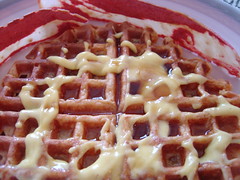
We've tried a few Alton Brown recipes in the past, and although he's quite entertaining, in practice some of his recipes lack a little pizzaz. Not this one though.
The sweet potato waffles from the Potato, My Sweet episode are just killer.
Just one problem.
The recipe calls for SIX egg whites, (to add levity to the seriousness of the sweet potato puree. They get folded in with a spatula, like a souflee batter!) But Alton offers no plan for the leftover yolks. (Quite unlike him, I know!) So we needed an egg-yolk rich solution that goes good with waffles. Our answer: Zabaione.
Zabaione is a simple Italian custard. The recipe is simplicity itself, 1 part egg yolk to 1 part sugar to 1 part sweet dessert wine, usually Marsala. (Although we used grappa. An Italian journal friend of mine would now tell me that I've not made zabaione, because I've broken with tradition. (Brutta Figura!) But Gina DePalma's book Dolce Italiano scoffs at this, and says that different regions in Italy do indeed use different sweet wines in their zabaione.)
But I digress. So how the heck do you measure 1 part egg yolk? The Italians use half the eggshell after the egg is cracked. So for one egg, you'd use a shell full of sugar and a shell full of wine. This way the size of the egg determines the amount of sugar and wine! (Those clever culinary geniuses.) But if you live in fear of eggshells, an egg yolk is about 1 Tablespoon. So a tablespoon of sugar and a tablespoon of wine for each yolk will work out fine. So the ratio is simple, the measurement is simple, this stuff is simple, right? Not quite. The trick is in the technique.
Fill a saucepan with enough water so that the water doesn't touch the bottom of the bowl when a large bowl is placed over the saucepan to make a double boiler. Take the bowl off the boiler. Start the water and when it hits a simmer, mix the yolks in the bowl with the sugar until well combined, then slowly add the wine. Once this is all incorporated, put over the simmering water and wisk, wisk, wisk. Put it on the water and wisk for a minute, then take it off for a minute and wisk. Do this until the mixture becomes pale yellow and begins to thicken. Eventually, when you take the wisk out, the pudding falling off the wisk will begin to stand on the surface of the pudding in the bowl. At that point, it is done. Take it off the heat, and serve, or store for up to a day in the fridge, tightly covered.
These waffles, this custard, and some pure maple syrup, were just about heaven. WARNING! The grappa is strong stuff, and the zabaione comes together in about five minutes, not nearly long enough to burn off all the alcohol, so you end up with some very "mature" waffles.
We had quite a bit of zabaione left, but it lived a short and charmed life, meeting its untimely end as a guilty topping for low fat vegan chocolate brownies, which is a recipe for another day, I think.
Friday, May 9, 2008
Garden Celebration Risotto with Basil-Walnut Pesto
Another tasty recipe from the Gardener's Community Cookbook. This risotto is full of veggies: carrots (more of those wonderful ones from the farmer's market), tatsoi (instead of the spinach called for in the recipe), asparagus, and leeks. The recipe called for peas and summer squash too, but we left those out because we had so much asparagus. The basil-walnut pesto (seen here on the top) is not much to look at, but is very good--it is essentially a normal pesto, but with walnuts instead of the traditional pine nuts.
Thursday, May 8, 2008
Farmer's Market Casserole
This casserole comes from the Gardener's Community Cookbook. It is another great recipe for using spingtime veggies. This contains fingerling potatoes, an onion, zucchini, tomatoes, carrots, fresh thyme and marjoram, a dry white wine, some bread cubes for the top and a little bit of cheddar cheese. I almost licked my bowl clean this was so good. The baby carrots that we bought at the farmer's market were especially good. We could smell the carrots from a couple of booths away.
Wednesday, May 7, 2008
Stir-Fried Rice Noodles with Asparagus and Eggs
This gem of a recipe comes from our favorite recipe guy, Jack Bishop. The recipe is out of A Year in a Vegetarian Kitchen. This cookbook is a real winner and I don't think that we have had anything bad out of it.
The asparagus have been very good this year so we have been eating a lot of them and have been looking for interesting recipes to put them in. This recipe fit the bill.
This recipe is really made tasty by the tamarind pulp. Apparently the taste of tamarind pulp is very different from tamarind paste. We couldn't find any for the longest time and would use tamarind paste instead (although both are tasty, they are indeed very different in flavor). We finally found some tamarind pulp at a local Indian grocer. It subsequently sat in our kitchen cabinet for many months until I came across this recipe and remembered that we had the pulp in the cabinet. In order to use the pulp, you have to cut a chunk off of the sticky block and soak it in boiling water until it softens. The liquid then has to go through a mesh strainer to remove the fibers and the seeds. It doesn't sound so great, but it really adds a wonderful flavor. The eggs in this recipe sucked up the flavor and I bet just eggs with tamarind pulp would be a good breakfast.
Oh, the other secret to this recipe is the roasted peanut oil. This cookbook in particular uses a lot of the roasted peanut oil, but we had subbed a different kind of oil each time because the roasted peanut oil is a little pricey (about $6 for a medium sized bottle). One time when we had a discount coupon for our co-op, we bought a bottle and we will never look back. This oil adds so much flavor and you only need to use a little bit of it to get the flavor in there so I guess the price isn't too bad. If you have never tried roasted peanut oil, I highly recommend it. We get a brand that is simply labeled as peanut oil, but you can tell that it is roasted by the dark color (and the label on the side of the bottle that indicates that the peanuts are roasted).
Believe it or not I have another story related to this dish. The recipe called for linguine size rice noodles. We could not find this size rice noodles anywhere. The co-op normally has them, but they were out (which is funny because when I was looking for thin rice noodles all they had were fat ones). We went to several different places with no luck. Finally we went to Japantown and the 3rd grocer we went to had them. I would not have purchased anything else from this particular grocer however because they were selling out of date products at a discounted price--totally illegal, but what you gonna do? Report them?
Tuesday, May 6, 2008
Spring Frittata
We are a little bit behind on the food blog, but sometimes life gets in the way.
Here we have a delectable spring frittata from the Gardeners' Community Cookbook. This cookbook is great when the variety of offerings in the produce department expands in the spring and summer.
This frittata has a ton of different spring ingredients in it: fingerling potatoes, artichokes, sweet onions, rosemary, parrsley, and a few different kinds of cheese. It was very tasty and huge so it made for a couple of lunches as well.
This frittata should probably be cooked in something other than an iron skillet so that the iron taste does not get into the eggs (although we couldn't really taste any iron this time). We don't have an oven safe skillet that is large enough for frittata so this always gets used. As you can see it is well seasoned. I think this pan is about 13 or 14 years old which makes it a couple of years older than our marriage.
